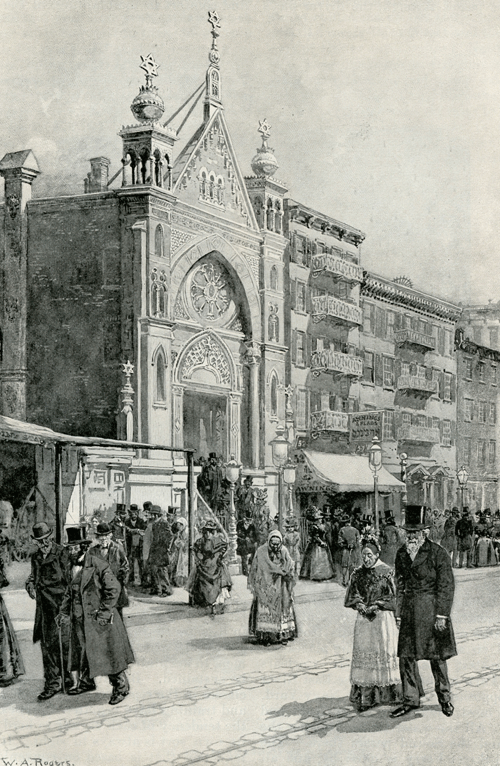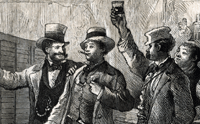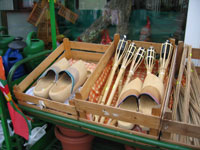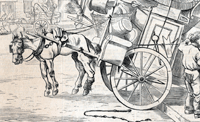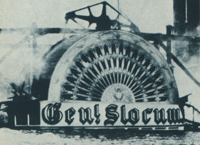The Germans who arrived in New York City at the time in question were generally Lutheran, Calvinist, Catholic or Jewish. Others, as demonstrated by my ancestors, joined alternative denominations such as Presbyterian and Methodist. Freethinkers were a smaller number who, regardless of pervious affiliation, rejected formal religion altogether.
In general German immigrants were not big church goers. Although nominally belonging to a given denomination they did not attend on a regular basis but went to church on holy days and to celebrated rites of passage (baptism, confirmation, marriage, death). Kleindeutchland was said to be a secular community where church played a minor role in social life. Much more important were the various social clubs, singing and shooting societies.
Some Places of Worship, Jewish
Preceding the influx of Eastern European Jews in the area, the German Jews build at least two synagogues.
-
The first synagogue in the Lower East Side built specifically as a
synagogue currently houses Angel Orensanz, a cultural center for the performing arts. Built in 1849 it is
located at 172-176 Norfolk Street (just south of Houston), 6 blocks west of 88 Sheriff St.
- In 1853 another synagogue was built at 8 Clinton Street (just south of Houston), 4 blocks west of 88 Sheriff. A reformed congregations established by German Jewish immigrants, that congregation eventually moved to the Upper West Side. In 1891 building was taken over by a congregation of Polish Jews.
Some German Speaking Places of Worship, Christian
The Christian German immigrants were primarily divided into Lutheran and Catholic. However, there were other Protestant denominations represented. Peter Goehle's family were Catholic in Germany yet he eschewed both the German Catholic congregations on the Lower East Side and the more prominent Protestant congregation of the Lutheran faith. Most of family rituals that have been found so far were performed in smaller Protestant congregations, namely Presbyterian.
- St. Nicholas Kirche (1833) was the first German Catholic Parish in New York City.
The church was opened in 1836 on 2nd Avenue between 1st and Avenue A. The building no longer stands,
although the rectory still remains.
Isabelle Walsh and Frank Goehle were married in St. Nicholas in 1921. Frank converted
the Catholicism around the time of his marriage.
To see an image of St. Nicholas church see First Avenue above
or go to
St. Nicholas German Catholic Church
and
Frank Goehle
The rectory was build in 1867. The church was demolished in 1960.
-
Holy Redeemer Roman Catholic church on 3rd Street between A and B was
build in 1851. The 250 tower, although modified, still
rises above the Lower East side.
- German Reformed Churches at:
- 21 Forsythe later at 129 Norfolk Street
- Avenue B at 5th
- The Second German Evangelical Reformed Church
Madison and Montgomery Streets.
Peter Goehle and Catherine Christ were married in this church in 1875. Catherine Lindeman, the younger, and Charles BeyerKohler were married in this church in 1888. The church is no longer standing.
- St. Mark's Lutheran Church at 323 6th Street between 1st and 2nd Avenue
Founded 1846. Community Synagogue since 1940.
- German Evangelical Church, Rivington Street
The German Evangelical Church (AKA 1st German Presbyterian Church) at 89-93 Rivington Street was originally built circa 1857.
This was the church in which Julius Lindermann and Catherine Furst were married at in 1863 and where their daughters were baptized: Elizabeth in 1864 and Sophia Catherine in 1866. Several sites on the internet say the building was bought by an Orthodox German Jewish congregation in 1864. So the German Evangelical Congregation may have been somewhere else by the baptism of Sophia in 1866. It subsequently became the home of the Allen Street Memorial Church in 1890. In 1902 it housed the First Roumanian-American Congregation (Jewish). The building collapsed in January 2006.
Listed at this address in the 1895 New York Times article LOOK FOR A DRY SUNDAY was the Second Street Methodist Episcopal, 91 Rivington.
- Emmanuel Presbyterian Church, 737 6th Street
According to a plaque on the front of the church: The church was founded in 1852, built in 1874 and reconstructed in 1970.
Another plaque on the front of the building is in memory of the Rev Erastus Seymour born 18th November 1830 and died April 13, 1891 "For the last 27 years of his life the greatly beloved pastor of this church"
The old church was torn down and a new church build in 1970. There is a picture of the old church in the foyer of the present building. However, it is hung very high on the wall and I was unable to get a decent picture of it.
Goehle rites at this church include: 1901 marriage of Louise Goehle and John Irving, 1901 marriage of Catherine Goehle and Emil Kirkebye, 1908 marriage of Peter Goehle and May Beckley, 1917 marriage of Margaret Goehle and Joseph Muntyan.
There were a number of mission and "tract churches" in the Lower East Side. These churches were concerned with the physical as well as the spiritual lives of their congregations. They sought to show the sinner the error of his ways. They sought to convert the Jew as well as the misguided Catholics. They were against the consumption of alcohol.
Christian Places of Worship in the Lower East Side listed in a New York Times article on July 2, 1895
LOOK FOR A DRY SUNDAY, July 2, 1895, New York Times listed the following congregations who took a stand against the consumption of alcohol on Sunday. Some of these congregation were listed under more than one name.
Four of these churches: Broome Street Tabernacle, Camp Memorial Congregational, DeWitt Memorial and Olivet shared personal and regularly report on their work in the New York City Mission and Tract Society monthly in 1899 and 1900.
-
Allen Street Memorial Methodist Episcopal,
91 Rivington
History of the Building that housed the Allen Street Memorial Church and other congregations.
Allen Street Memorial was a proselytizing mission. Renamed the Allen Street Methodist Episcopal Church (or Allen Street Memorial Church), the Rivington Street building's new purpose was to "attract Jewish immigrants seeking conversion". It was, however, unsuccessful in this endeavor. In 1895 the church's pastor stated: "The existence of the church here attracts few. Our audiences are small, and contain almost no Jews."
Also listed separately in the July 2 1895 article were the Hebrew-Christian Missionary in Allen Street Presbyterian Church at 126 Forsyth Street and Second Street Methodist Episcopal at 91 Rivington
See German Evangelical Chruch above.
- Baptist Tabernacle, 166 Second Avenue, AKA Second Avenue Baptist Church,
Second Avenue between 10th and 11th
"The Southern New-York Baptist Association will hold its nineteenth anniversary at the Baptist Tabernacle, 166 Second-avenue, beginning this afternoon at 3 o'clock and continuing to-morrow and Thursday.
New York Times October 8, 1889
"The Baptist Tabernacle, at 166 Second Ave, adjoining the Historical Society, was formed in 1839 by members of the Mulberry-Street Church."
The building was erected in 1850 and the interior was remodeled in 1886. The Baptist Tabernacle was a mission church.(King's handbook of New York city: an outline history and description of the ... edited by Moses King, 1892)
- Broome Street Tabernacle, 395 Broome Steet
"a station of the New York City Mission and Tract society, and the center of an important work among the 60,000 English-speaking people in its vicinity, for whom there is not other Protestant church.....
The Lodging House mission carries on an aggressive missionary work in the lodging-houses in the vicinity of the Tabernacle."
(King's handbook of New York city: an outline history and description of the ... edited by Moses King, 1892)
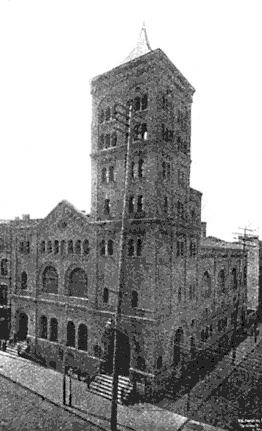
Broome-Street Tabernacle, Broome Street and Centre Market Place
King's handbook of New York city: an outline history and description of the of the American metropolis, edited by Moses King, 1892
- Camp Memorial Congregational, 141 Chrystie Street
"Down in the very heart of what is known as the "Red Light" district of New York is a Congregational Church that has been in existence as a religious institution for over sixty years. It is a Home Missionary Church."
The congregation later moved to 141 Chrystie street.Established in 1839 as a mission, it was in good company down-town then, for those were the days before the wealthy churches began to migrated northward......
It was not until 1859 that this work became organized as a church - then being called the Centre Street Mission Church. About 1872 a move was made to Elizabeth street, the name being changed to that of Camp Mission. There is continued until April 25, 1889, when it was recognized by Council as a regular Congregational Church."
"It is a genuine slum church, situated in the most cosmopolitan part of the most cosmopolitan city in the world. After half an hour or an hour in viewing this section of the city one might almost imagine that one had visited different parts of the globe. A few blocks from the church, just across the notorious Bowery, is a section almost entirely inhabited by Italians, and as one passes down Mulberry street, noting the barrows of native venders of fruits and vegetables which line the street, observing the peculiar native costume worn by many, and listening to the ceaseless chatter of a foreign tongue, one might be forgiven did he for a moment think he had been transported into some Italian town........
There were 73,000 people in the Tenth Ward, 80% Jewish .Then across the Bowery again and into the wicked Tenth Ward - our own ward - and we enter what has been termed by some the biggest Jewish city in the world.
"It has been stated that the Tenth Ward is the most densely populated and probably the wickedest ward in the city.......
The area was filled with "loafers who seldom work" and men and women from all over the world and off all "social scale" who had "fallen to the bottom" inevitably "because of drink". There were reportedly 150 saloons and places where liquor was sold in the 10th ward.Theaters, music halls, saloons and other agencies for the destruction of all that is good in our population abound here. The notorious Bowery, a portion of which is in this ward, of course, considerably augments the number. It is lined with cheap lodging houses, theaters - in some of which the performance is in Yiddish, the Hebrew dialect of the East- music halls, saloons, nickel-in-the slot- places which cater to the morbid desire to see something low and sensual, shooting galleries, museums, and other fakes and shams, one or two missions, and a few respectable business house."
To compact the perils of sin and vice there were only three Christian Churches "with a total membership of less that 300".
"One saloon and the other degrading influences mentioned to 500 of the population on the one hand, one church to 24,000 people on the other."
The Home missionary, Volumes 74-76 By American Home Missionary Society, Congregational Home Missionary Society Cathedral Mission, 13(8?)) Stanton Street, 1902
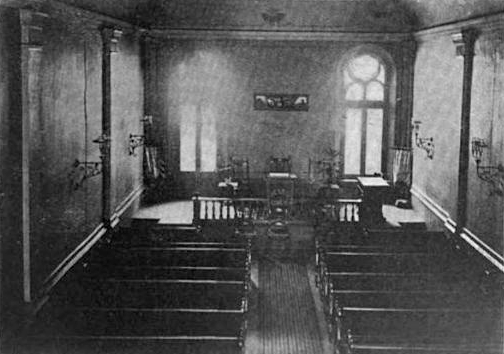
Camp Memorial Church - Interior, Home missionary, Volumes 74-75 By Congregational Home Missionary Society

Camp Memorial Church - Exterior, Home missionary, Volumes 74-75 By Congregational Home Missionary Society
- De Witt Memorial Church, 280 Rivington Street,
Nondenominational
An outgrowth of the Lebanon Chapel on Columbia Street it was dedicated in 1881. De Witt Memorial was a mission church and tract society that proselytized to Germans and Jews.
Listed under "Missions to the Destitute"
DE WITT MEMORIAL CHURCH 280 Rivington St
In August of 1892, Hermann Warszawiak wrote:
GERMAN MISSION carried on at De Witt Memorial Church
JEWISH MISSION " " " "The New York charities directory By Charity Organization Society of the City of New York
"the 'De Witt Memorial Church' can only hold about 900 people, while our audiences of Israelities [sic] at the chief meeting day, every Saturday afternoon, has grown within the last year to about twice that number, we are too often obliged to send away hundreds of people who in their anxiety come to hear the story about the crucified Redeemer, and are no little disappointed to learn that they cannot get into the church on account of having no more room. As a rule the church is crowded and packed to its utmost capacity every Saturday, a half hour or an hour before the real service or preaching begins." This estimate of audience size was confirmed by reports of various visitors who attended, as reported in Salvation magazine or in The Little Messianic Prophet
In 1900 the church offered sewing classes to young Jewish women:(The Tragedy of Hermann Warszawiak
Richard A. Robinson)Lausanne Consultation on Jewish Evangelism, North America Dallas, TX, February 24-26, 2003
"This work is valuable, not only in that it gives much needed instruction in sewing, but in breaking down prejudices, which now make it extremely difficult for a Jewish child to accept the Christian faith. In some instances, where a child has become deeply interested in the Christian religion, the family by ridicule and threat have forced the young believer to leave us"
The church baptized one adult Jewish convert in 1900.(New York City mission monthly, Volumes 12-13)
-
German Moravian, AKA United Brethren (Unity of Brethren), 636 Sixth Street
(between Avenue B and Avenue C)
Located at this address from 1872-1906.
Established in 1855 as The First Mission
Church and Congregation of the United Brethren's Church of New york." it
had no permanent address until 1872. It was sold to a "Hebrew" congregation in 1906.
(A history of the Moravian church in New York city By Harry Emilius Stocker)
- German Reformed Church of America, AKA First German Reformed
Church 147 Norfolk
FIRST GERMAN REFORMED (third site) 149-153 Norfolk Street. Erected 1861. Previously at 21 Forsyth street. Subsequently at 353 E. 68th Street.
(Stokes, I. N. Phelps The iconography of Manhattan Island 1498-1909 (v. 3) (New York : Robert H. Dodd, 1915-1928.))
The Astors, The Schermerhorns and Baron von Steuben were early members. The church was originally founded in 1750 and moved several times over the years.
- Middle Collegiate Church, AKA Marble Collegiate, 50 Seventh Street at 2nd Avenue.
Tiffany windows. Dutch Reform. Present church dedicated 1854.
Marble Collegiate Church (Dutch Reformed)
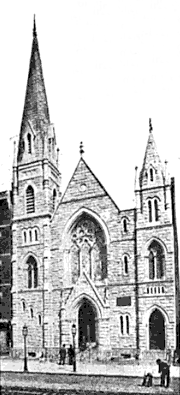
Collegiate Church, 7th Street and Second Avenue
King's handbook of New York city: an outline history and description of the of the American metropolis, edited by Moses King, 1892
- Olivet Memorial Church (New York Mission and Tract Society) 63 Second Street
The New York Times announced on February 2, 1891 that the last services were held in the "old" Olivet Church at 63 Second Street in preparation to rebuilding on the site. The church was located in the 17th ward and had "distinct English and German branches, with English and German pastors and missionaries". It was under the auspices of the New York City Mission and Tract Society. The church used temporary quarters at the Seventh Street Methodist Episcopal Church.
According to a report in 1900 the German mission had an average attendance of 100 at the Monday evening prayer meeting. The mission included not only "preaching and teaching" but house to house visits to "the sick and the poor, seeking those who have gone astray, and trying to reach the sinners with the Gospel in their homes".
- Living Waters Mission, 136 Chrystie Street
A memorial service was held at DeWitt Memorial in 1908 for a former truck driver, drunkard, and bum who was converted and became a missionary himself and ran the Living Water Mission on Chrystie Street.
"At 136 Christie street is the Mission of the Living Water, founded in 1894. The work was for many years in charge of the first missionary, John Jaeger, a very able, but uneducated man, converted from a notoriously evil life."
John Jaeger died in 1908(The Better New York By William Howe Tolman)
"SLUM MISSIONARY DIES. John Jaeger Worn Out in Work of Saving East Side Drunkards.
John Jaeger, for twenty-five years one of the best Known missionary workers on the East Ride, died on Saturday - worn out in the work. He was a former truck driver, a drunkard, and in the words of his wife, "a bum" until one evening he went to the old Jerry McAuley Mission, at No. 316 Water street. There he became, converted, and since then had given his time to missionary work. For the last five years Jaeger, who with his wife conducted the Mission of the Living Waters, at No. 2? Dalancey street, had been an invalid. Nevertheless, he had done some missionary work each day. He had no particular disease: his associates say he was Just worn out in his work. He was sixty-four years old. The funeral will be held at 2 p. m. tomorrow at the De Witt Memorial Church, No. 280 Rivington street, of which he once was sexton. The story of Jaeger's conversion was typical of the McAuley Mission work. Bradford Lee Gilbert, a mission worker, had his attention called to the German by his children, who attended Mr. Gilbert's Sunday school class. Jaeger was half drunk at the time and suffering from an arm broken by a fall from his truck when drunk. Mr. Gilbert took him to the McAuley Mission, where Jerry himself labored with him, and got a German convert to work with him as Jaeger could talk no English. That night, according to testimony delivered by him twenty-one years later at his mission, he went to his wife, saying, "I have got Jesus." "Oh, John, you are a lier" was her reply. "I wouldn't trust you five minutes." "The five minutes are twenty-one year to-night," he went on. "I pray for the backslider and fault finder; I pray for all nations on the face of the earth; I pray ior the mission worker: I pray for those who lie in the gutter, because I know what it is to sleep in cellars, though I don't look like it to night, because I am redeemed." Jaeger braced up immediately, and while still driving his truck took up the work of saving drunkards. Later he became sexton of De Witt Memorial Church, in connection with the missionary work, and still later opened the Mission of the Living Waters with Mrs. Jaeger.
New-York Tribune. (New York [N.Y.]) June 28, 1908, Image 10
- Second Street Methodist Episcopal, 256 Second Street
Known as the "little red chapel of the east side", the Second Street Methodist Episcopal dated to 1832.
-
St Bridget's Roman Catholic
Tompkin's Square 119 Avenue B was built in 1848 with money donated by Irish famine immigrants. It was closed in 2001 and was about to be demolished when a mystery benefactor gave money for its renovation. The church was reconsecrated in January 2013.
- Seventh Presbyterian Church, 138 Broome Street AKA the Seventh Church of Jesus Christ.
The Seventh Presbyterian Church was organized in 1818 and was originally located on Sheriff street. It moved to Broome Street in 1827. The church burned in 1831 and was rebuilt. Ii was listed in the Annual report of the New York City Mission and Tract Society By New York City Mission and Tract Society in 1872.
In 1886 the church was "the oldest Presbyterian edifice in the city, and in the days of its infancy was the fashionable up-town church. (New York Times, June 29, 1886)
- Seventh Street Methodist Episcopal , 23 Seventh Street AKA the Bowery Village Church. The church was erected in 1878.
- University Settlement Society 26 Delancey
The University Settlement Society was technically not a church.
The University Settlement Society was originally organized in 1887 as the Neighborhood Guild. It aimed to organize the "people of the neighborhood" regardless of religion or political belief to carry out moral, industrial and educational reforms.
Part of their stated purpose for 1893-94 was set forth in a New York Times article of December 15, 1893
"The public must help us to establish baths and laundries, underground street lavatories, small parks, labor intelligence bureaus, sick benefits societies based on sound insurance principles, summer seaside residences for working people, and other well tested devices for advancing the character, health, and happiness of the dwellers in the Tenth Ward of New York City, the most crowded population to the square mile on the earth."
-
Willett Street Methodist Episcopal, 9 Willett Street
Located between Grand and Broome the Willett Street Methodist Church was built 1826. The church disbanded in 1905 when the building was purchased by the Bialystoker synagogue.
Image of the Seventh Presbyterian Church
One of the commitments of the Seventh Street Methodist church was to establish missions "to reach the masses living in the crowded parts of the City, who were mostly foreigners." (New York Times July 12, 1875)
Other Congregations on the Lower East side
King's handbook of New York city: an outline history and description of the of the American metropolis, edited by Moses King, 1892 included St. Augustine's Chapel Protestant Episcopal erected in 1876-77 at 107 East Houston near the Bowery: "In a section where vice and poverty abound". It contained two main parts: a mission house and the church. "The work is almost entirely among the poorer classes of the neighborhood".
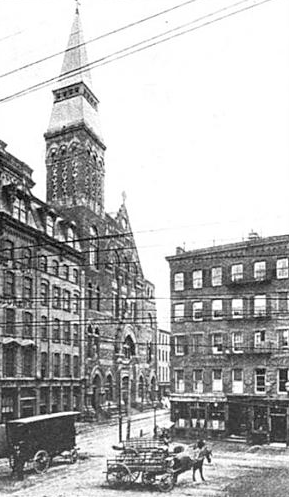
St Augustines
